中国棉花研究进展
- 格式:pdf
- 大小:80.39 KB
- 文档页数:5
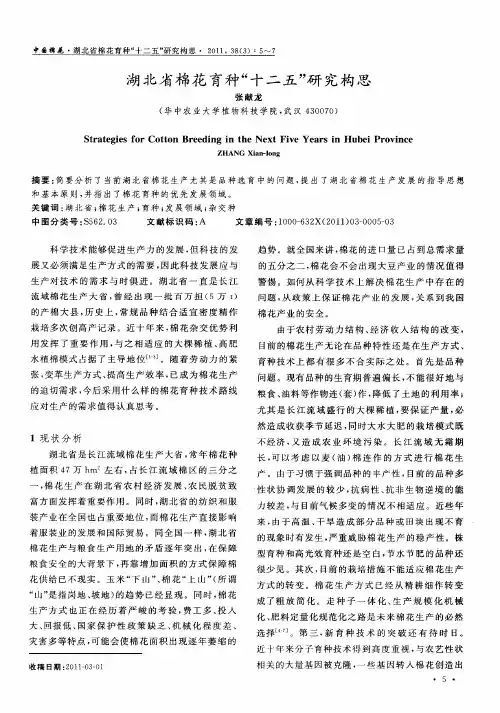
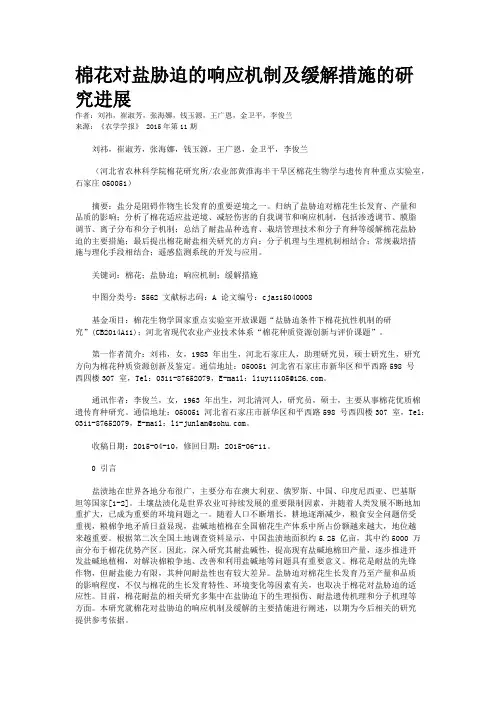
棉花对盐胁迫的响应机制及缓解措施的研究进展作者:刘祎,崔淑芳,张海娜,钱玉源,王广恩,金卫平,李俊兰来源:《农学学报》 2015年第11期刘祎,崔淑芳,张海娜,钱玉源,王广恩,金卫平,李俊兰(河北省农林科学院棉花研究所/农业部黄淮海半干旱区棉花生物学与遗传育种重点实验室,石家庄050051)摘要:盐分是阻碍作物生长发育的重要逆境之一。
归纳了盐胁迫对棉花生长发育、产量和品质的影响;分析了棉花适应盐逆境、减轻伤害的自我调节和响应机制,包括渗透调节、膜脂调节、离子分布和分子机制;总结了耐盐品种选育、栽培管理技术和分子育种等缓解棉花盐胁迫的主要措施;最后提出棉花耐盐相关研究的方向:分子机理与生理机制相结合;常规栽培措施与理化手段相结合;遥感监测系统的开发与应用。
关键词:棉花;盐胁迫;响应机制;缓解措施中图分类号:S562 文献标志码:A 论文编号:cjas15040008基金项目:棉花生物学国家重点实验室开放课题“盐胁迫条件下棉花抗性机制的研究”(CB2014A11);河北省现代农业产业技术体系“棉花种质资源创新与评价课题”。
第一作者简介:刘祎,女,1983 年出生,河北石家庄人,助理研究员,硕士研究生,研究方向为棉花种质资源创新及鉴定。
通信地址:050051 河北省石家庄市新华区和平西路598 号西四楼307 室,Tel:0311-********,E-mail:liuyi1105@。
通讯作者:李俊兰,女,1963 年出生,河北清河人,研究员,硕士,主要从事棉花优质棉遗传育种研究。
通信地址:050051 河北省石家庄市新华区和平西路598 号西四楼307 室,Tel:0311-********,E-mail:li-junlan@。
收稿日期:2015-04-10,修回日期:2015-06-11。
0 引言盐渍地在世界各地分布很广,主要分布在澳大利亚、俄罗斯、中国、印度尼西亚、巴基斯坦等国家[1-2]。
土壤盐渍化是世界农业可持续发展的重要限制因素,并随着人类发展不断地加重扩大,已成为重要的环境问题之一。

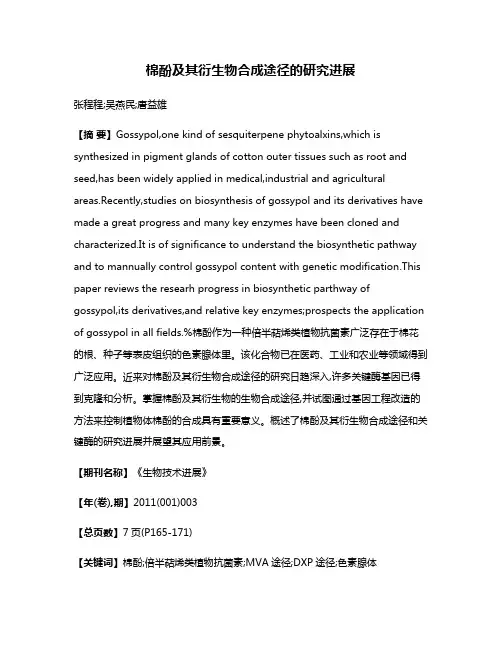
棉酚及其衍生物合成途径的研究进展张程程;吴燕民;唐益雄【摘要】Gossypol,one kind of sesquiterpene phytoalxins,which is synthesized in pigment glands of cotton outer tissues such as root and seed,has been widely applied in medical,industrial and agricultural areas.Recently,studies on biosynthesis of gossypol and its derivatives have made a great progress and many key enzymes have been cloned and characterized.It is of significance to understand the biosynthetic pathway and to mannually control gossypol content with genetic modification.This paper reviews the researh progress in biosynthetic parthway of gossypol,its derivatives,and relative key enzymes;prospects the application of gossypol in all fields.%棉酚作为一种倍半萜烯类植物抗菌素广泛存在于棉花的根、种子等表皮组织的色素腺体里。
该化合物已在医药、工业和农业等领域得到广泛应用。
近来对棉酚及其衍生物合成途径的研究日趋深入,许多关键酶基因已得到克隆和分析。
掌握棉酚及其衍生物的生物合成途径,并试图通过基因工程改造的方法来控制植物体棉酚的合成具有重要意义。

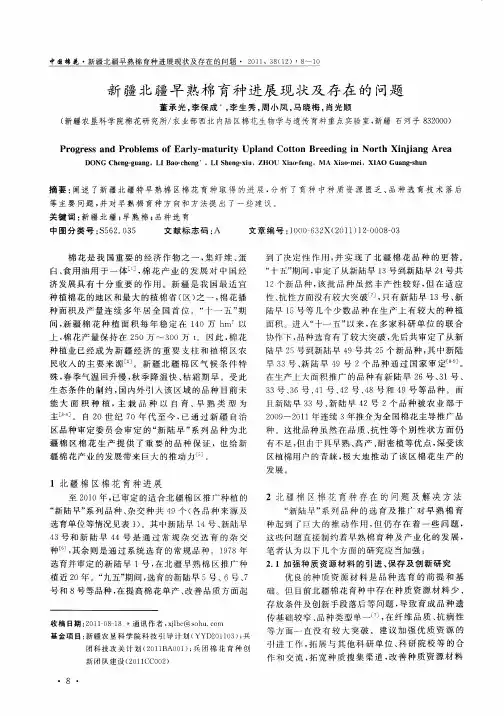
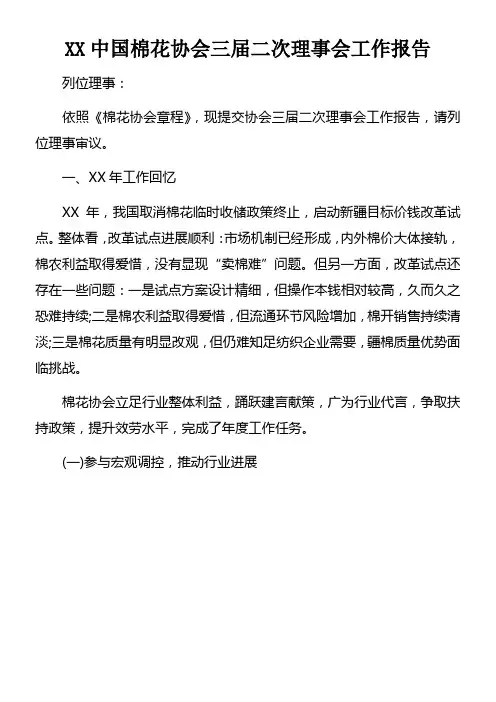

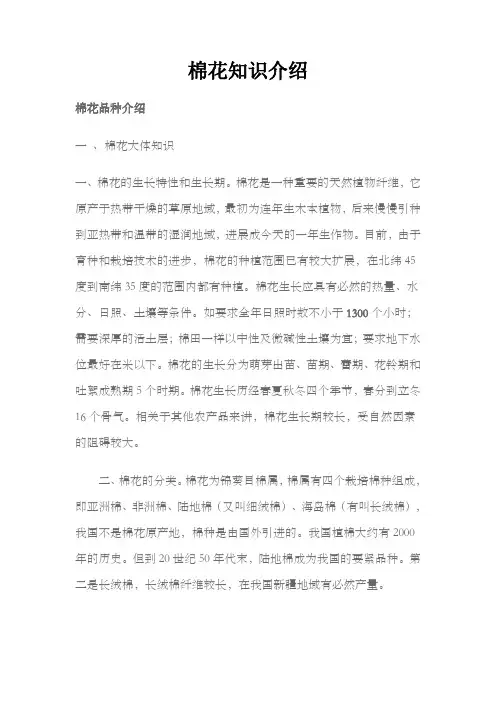
棉花知识介绍棉花品种介绍一、棉花大体知识一、棉花的生长特性和生长期。
棉花是一种重要的天然植物纤维,它原产于热带干燥的草原地域,最初为连年生木本植物,后来慢慢引种到亚热带和温带的湿润地域,进展成今天的一年生作物。
目前,由于育种和栽培技术的进步,棉花的种植范围已有较大扩展,在北纬45度到南纬35度的范围内都有种植。
棉花生长应具有必然的热量、水分、日照、土壤等条件。
如要求全年日照时数不小于1300个小时;需要深厚的活土层;棉田一样以中性及微碱性土壤为宜;要求地下水位最好在米以下。
棉花的生长分为萌芽出苗、苗期、蕾期、花铃期和吐絮成熟期5个时期。
棉花生长历经春夏秋冬四个季节,春分到立冬16个骨气。
相关于其他农产品来讲,棉花生长期较长,受自然因素的阻碍较大。
二、棉花的分类。
棉花为锦葵目棉属,棉属有四个栽培棉种组成,即亚洲棉、非洲棉、陆地棉(又叫细绒棉)、海岛棉(有叫长绒棉),我国不是棉花原产地,棉种是由国外引进的。
我国植棉大约有2000年的历史。
但到20世纪50年代末,陆地棉成为我国的要紧品种。
第二是长绒棉,长绒棉纤维较长,在我国新疆地域有必然产量。
3、棉花的加工与查验。
棉农从棉棵上摘下的棉花叫籽棉,籽棉通过加工后去掉棉籽的棉花叫皮棉,适应上所说的棉花产量,一样都是指的皮棉产量。
锯齿轧花机加工出来的皮棉叫锯齿棉,皮辊轧花机加工出来的皮棉叫皮辊棉,皮辊棉轧工质量不行,生产效率低;齿轧花机加工出来的皮棉轧工质量好,但对棉花纤维有必然的损伤,目前陆地棉的加工大体上都用锯齿轧花机,长绒棉的加工利用皮辊轧花机。
籽棉加工成皮棉的比例是10:3,即每10吨籽棉可加工成3吨皮棉。
轧花机加工成的皮棉经打包机打成符合国家标准的棉包。
国家标准皮棉包装有三种包型:85千克/包(±5千克);200千克/包(±10千克);227千克/包(±10千克)。
棉花查验是严格依照国家标准GB进行的。
依照棉花的成熟程度、色泽特点、轧工质量这三个条件把棉花划分为1至7级及等外棉;又依照棉纤维的长度25—31mm划分有长度级,棉花长度级以1mm为级距。
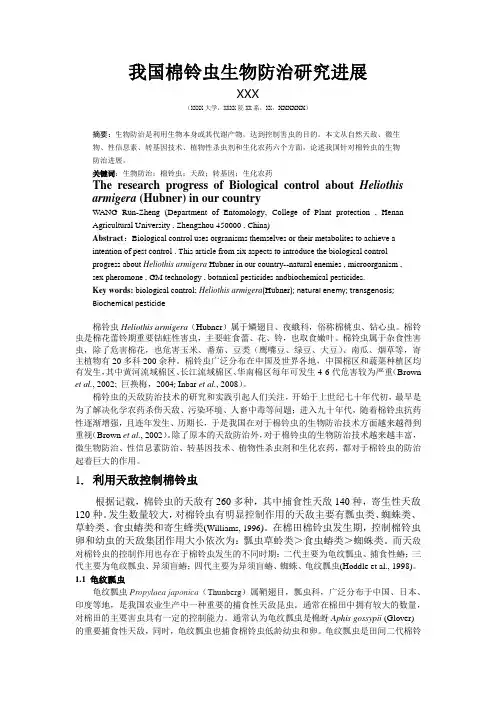
我国棉铃虫生物防治研究进展XXX(XXXX大学,XXXX院XX系,XX,XXXXXX)摘要:生物防治是利用生物本身或其代谢产物,达到控制害虫的目的。
本文从自然天敌、微生物、性信息素、转基因技术、植物性杀虫剂和生化农药六个方面,论述我国针对棉铃虫的生物防治进展。
关键词:生物防治;棉铃虫;天敌;转基因;生化农药The research progress of Biological control about Heliothisarmigera(Hubner) in our countryWANG Run-Zheng (Department of Entomology, College of Plant protection , HenanAgricultural University , Zhengzhou 450000 , China)Abstract:Biological control uses orgranisms themselves or their metabolites to achieve aintention of pest control . This article from six aspects to introduce the biological controlprogress about Heliothis armigera Hubner in our country--natural enemies , microorganism ,sex pheromone , GM technology , botanical pesticides andbiochemical pesticides.Key words: biological control; Heliothis armigera(Hubner); natural enemy; transgenosis;Biochemical pesticide棉铃虫Heliothis armigera(Hubner)属于鳞翅目、夜蛾科,俗称棉桃虫、钻心虫。
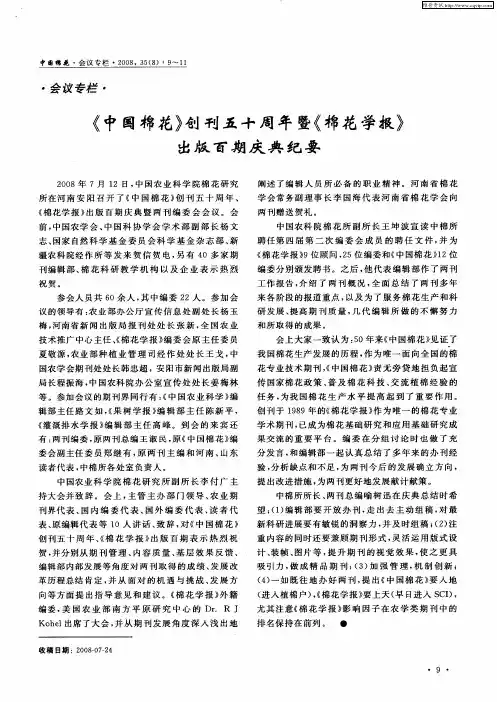
关于近代我国植棉业改良的研究综述作者:由毅来源:《西部学刊》2019年第17期植棉业改良是近代农业改良的重要部分。
十九世纪末二十世纪初,晚清政府开始盲目引进美棉棉种,进而引发中棉与美棉的混杂,以致棉质退化严重;至中华民国成立之后,国民政府、棉纺织企业家、农学家等开始对植棉业进行全面的、科学的改良。
目前已有的对近代植棉业改良的研究较为丰富,因而通过对现有研究的收集与分类整理,能够对近代植棉业改良工作有更加全面的了解。
现有的综合性研究可以粗略地分为两大类,一类是聚焦于某一特定棉区,对棉区的自然环境、农学科研、乡村农业教育、棉纺织业、农民群体等进行分析,以综合讨论该地植棉业改良的社会、政治背景,还原植棉业改良事业的发展历程以及对社会的影响。
如程翔宇通过梳理正定地区棉作研究机构、棉花商品化程度、棉花运销合作社、棉花品质检验工作、植棉贷款等方面的资料,探究科研、政策、市场等因素对正定植棉业改良工作的推动情况。
由于正定植棉业是近代中国植棉业改良工作的重点对象之一,且正定是优质棉花的生产基地、河北棉花的转运市场,研究正定这一特殊棉区的有关情况能够反映河北省植棉业的发展动态。
[1]此外,美国学者彭慕兰以华北地区的农业为研究对象,分析近代中国鲁西南棉区的成长及衰败过程,认为优越的地理条件,特别是棉纺织业振兴是植棉业改良的推动力,棉作研究、乡村农业教育推广对植棉业改良很重要。
同时彭慕兰通过对鲁西棉区拾荒、抢青、看青等活动的梳理以及对棉业公会的研究,认为其反映近代乡村日趋低下的社会风气,解析了近代农村社会结构的变迁。
[2]另一类则是以时间为轴线,以编写植棉业发展史的方式,将与植棉业改良的相关资料进行广泛的收集和详细的分类整理。
章楷等从中国两千多年棉花种植史的视角,展现植棉业改良的历程。
他客观地对长江流域、黄河流域各主要棉区的棉花种植史、棉作改良机构及改良的效果进行简要介绍,同时对棉作改良的主要工作、棉作改良机构、棉花品质检验机构、棉花贸易管理机构等进行较为详细的列举,为整体上分析近代中国植棉业改良工作提供参考。
棉花学报 Cotton Science 2002,14(6):378~382 专题与述评 国家棉花种质圃工作进展 王坤波 ,宋国立 ,黎绍惠。,王春英 ,张香娣 , 刘 方 ,于绍杰 ,崔荣霞 ,胡绍安 (1.农业部棉花遗传改良重点开放实验室中国农业科学院棉花研究所, 河南安阳455112;2.广东农业科学院经济作物研究所,广州五山510012)
摘要:国家棉花种质圃是国家32个农作物种质资 源种质圃之一,位于海南岛三亚市,依托于中国农 科院棉花所。自1982年建立以来,在多年生资源 的研究方面取得较好的成就,并形成一些工作特 色。常年宿生保存棉花材料500份左右,涵盖棉属 36个种(亚种)。在获得种间杂种、育种材料创新、 工具材料与诱变材料的收集与保存等方面,表现 了突出的工作优势。 关键词:棉花;种质圃;成就 中图分类号:¥562。024 文献标识码:A 文章编号:1002—7807(2002)06—0378—05
Achievements in National Cotton Plantation WANG Kun—bo ,SONG GUO—li ,LI Shao—hui , WANG Chun—ying ,ZHANG Xiang—di ,LIU Fang ,YU Shao—jie ,CUI Rong—xia ,HU Shao—an (1. Key Laboratory for Cotton Genetic Improvement,Ministry of Agriculture,P R China; Cotton Research Institute, Chinese Academy of Agricultural Sciences,Anyang, Henan,455112,P R China;2.Cash Crop Research Institute of Guangdong Province Academy of Agricultural Sciences, Wushan Guangzhou,510012,China) Abstract:National Cotton Plantation is one of thirty—tWO plantations for Chinese national crop germplasm.It was established in 1 982 and is located in Sanya City,Hainan Island and responded by Cotton Research Institute,Chinese
Chinese Science Bulletin © 2007 SCIENCE IN CHINA PRESS Springer
www.scichina.com www.springerlink.com Chinese Science Bulletin | January 2007 | vol. 52 | no. 1 | 1-5 ARTICLES
CROP BREEDING A brief summary of major advances in cotton functional genomics and molecular breeding studies in China
Qin YongMei1 & Zhu YuXian1,2† 1 National Laboratory of Protein Engineering and Plant Genetic Engineering, College of Life Sciences, Peking University, Beijing,
100871, China; 2 National Center for Plant Gene Research (Beijing), Beijing100101, China
Cotton fibers, commonly known as cotton lint, are single-celled trichomes derived from epidermal lay-ers of cotton ovules. Despite of its importance in word trade, the molecular mechanisms of cotton fiber production is still poorly understood. Through transcriptome profiling, functional genomics, pro-teomics, metabolomics approaches as well as marker-assisted molecular breeding, scientists in China have made significant contributions in cotton research. Here, we briefly summarize major progresses made in Chinese laboratories, and discuss future directions and perspectives relative to the develop-ment of this unique crop plant.
Gossypium, cotton fiber, functional genomics, gene cloning, molecular breeding
Cotton accounts for about one half of the world’s natural fibers and is one of the most important economic crops in China. The Ministry of Science and Technology of the People’s Republic of China (MOST) initiated cotton functional genomics research through the High-Tech- nology Research and Development of China (“863”) in 1997 and through the “industrialization of transgenic plants” program in 1999. More recently, MOST initiated a project in the National Basic Research Program of China (973) to support the research aiming for the im-provement of both cotton lint production and fiber qual-ity. Indeed, among the 2469 research articles published in PubMed accessed journals in the last 5 years (2003—2007) that concentrated on cotton sciences, 340 were contributed by Chinese laboratories (Table 1). We thus hold a very strong second position only to United States of America which published 783 in the same period of time, in a close concert with the country being world’s number one cotton producer and manufacturer. Gossypium hirsutum and G. barbadense are natural cotton species that are allopolyploids. G. hirsutum, up-land cotton, accounts for about 92% to 95% of the an-nual cotton production in the world and generally grow
Table 1 Ranking of countries by number of articles published in PuB-Med accessed journals in last 5 years (2003―2007) with cotton as the main subject Country No. of publications USA 783 China 340 Japan 160 India 131 Australia 93 UK 83 France 51 Italy 44
up to 30―40 mm in length, about 15 μm in thickness at full maturity. G. barbadense, Sea Island cotton, repre-sents another 5% of cotton production. To fully under-stand the problem, our lab at Peking University per-formed a PCR-selected cDNA subtractive analysis using cDNAs prepared from upland cotton fiber as the testers and cDNAs from the fuzzless-lintless (fl) mutant[1] as
Received September 0, 2007; accepted October 19, 2007 doi: †Corresponding author (email: zhuyx@water.pku.edu.cn) Supported by the National Basic Research Program of China (Grant No. 2004CB117302) 2 QIN YongMei et al. Chinese Science Bulletin | Ja 2007 | vol. 52 | no. ? | 1-5
drivers, and showed that a great number of cotton genes were differentially expressed during different growth stages of the fiber[2]. We have since randomly sequenced a total of 102000 cotton ESTs (expressed sequence tags) from 0―10 days post-anthesis (dpa) cotton fiber cDNA library that accounted for about 1/3 of the cotton ESTs in GenBank databases and obtained 30154 UniESTs. As-sembly and in-depth microarray analysis of the first 12233 UniESTs revealed that more than 778 genes were specifically unregulated during fiber development[3]. Chen XiaoYa and colleagues[4] at the Institute of Plant Physiology and Ecology, Chinese Academy of Science (IPPE, CAS), have identified 633 genes that were dif-ferentially regulated during the same period of time through comparative transcriptome analysis. Similar work has been reported from Zhang Xianlong’s lab at Huazhong Agricultural University. They obtained 455 G. barbadense genes and found that almost 50% of them belong to metabolically functional categories[5], and suggested that many of these genes were associated with cotton somatic embryogenesis[6]. Metabolite profiles of cotton fiber cells provided by Chen Xiaoya’s group in-dicated that cellulose biosynthesis, cell wall-loosening and lipid biosynthesis were highly active during fiber elongation, which is consistent with transcriptome and proteomic data reported from other labs in China and around the world as well[3,4,7]. Liu JingYuan and colleagues[8,9] at Tsinghua Univer-sity developed a protocol for protein extraction from cotton fibers, which gave a higher yield, greater resolu-tion and spot intensities during subsequent two-dimen- sional electrophoresis. Our lab also performed compara-tive proteomic analysis using 10-dpa wild-type cotton ovules with fibers attached and fl mutant ovules that produced absolutely no fiber. A total of 1240 ± 20 pro-tein spots were detected on both gels and among them, 61 were either highly up-regulated or down-regulated[7]. 1 Gene cloning and functional analysis Fiber development can be divided into four develop-mental stages: (1) initiation, (2) elongation, (3) secon-dary cell wall thickening, (4) dehydration. The produc-tivity as well as the quality of cotton lint depended mainly on fiber initiation and fiber elongation since ap-proximately only 30% of the ovule epidermis develops to fiber. The initiation of a fiber cell was found devel-opmentally similar to that of the Arabidopsis trichome. Genes specifically expressed in developing cotton fiber cells encoded several transcription factors with similari-ties to the regulators of Arabidopsis trichomes[10]. For example, Chen XiaoYa[11] and colleagues found that a MYB gene (GaMYB2) from G. hirsutum, a homologue of AtGL1 encoding the Arabidopsis transcription factor R2R3 MYB, was able to rescue the Arabidopsis gl1 mutant and the expression of this cotton gene induced trichome formation on Arabidopsis seeds. Similar results were obtained from Xue YongBiao[12] in the Institute of